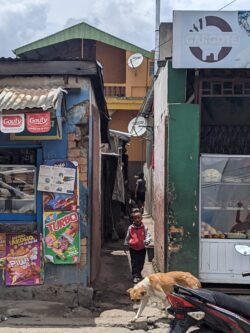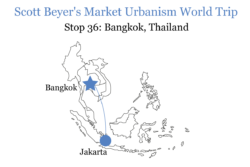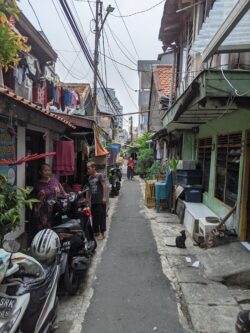The Market-Driven Superblocks of Southeast Asia
In Jakarta and Bangkok, narrow streets and densely-packed activity result from private spatial negotiations.
Before cars became the dominant transport mode in Western cities, buildings and roads were built at pedestrian scale. Inherent in this pattern was wide separation between standard arterial roads, and long blocks of buildings and alleys for pedestrians in between. Some Western cities retain this pattern in spurts, such as Barcelona, which has tried to intentionally plan such “superblocks”. Superblocks are now seen as a path to walkability, 15-minute cities, and other planning trends. But in the developing world they never disappeared; and resulted not from top-down government, but informal private negotiations between building owners.
While I have found superblocks throughout Latin America and Africa during my 1.5-year Global South trip, they’re particularly common, and originated, in Asia. The ancient Chinese city of Chengzhou was planned in a manner reflecting superblock development, according to Governing Cities: Asia’s Urban Transformation. Beijing was built the same way.
Superblocks remain the dominant pattern in poor developing world neighborhoods that are defined by crowding and lack of car ownership. In Antananarivo, Madagascar they’ve emerged through both absence of clear demarcation of property lines and voluntary agreements to subdivide narrow land slivers.

In the favelas of Rio de Janeiro, superblocks extend through the hills, with alleys curving along the land contours.
Two Southeast Asian cities I visited are particularly rife with superblocks: Jakarta, Indonesia, and Bangkok, Thailand. In Jakarta, central areas are surrounded by wide roads, but lack automobile thoroughfares through the neighborhoods themselves. These superblocks, called perkampungan, emerged because of competition for tight space, with narrow alleys passing between buildings. The sort of road space allocated to cars in the West would be impractical here, given high land values and prolific use of motorbikes, not 4-wheel automobiles.

While main alleys of central Jakarta are now controlled by the government, I learned from residents that they were often paved by farmers, and development moved toward them organically. And these areas have small private alleys too, which feed the wider ones, and result from negotiations between homeowners to allow access deep into the block.

Superblocks likewise emerged absent planning in Bangkok. They are traversed by narrow roads called sois that were built privately, while the main thoroughfares between superblocks were built by government planners.
“The soi where the majority of population in Bangkok lives is created by private initiative,” writes Davisi Boontharm of Tokyo’s Sophia University. An example is found in the city’s northwestern suburbs, where agricultural land was sold to create densely packed clusters of single-family homes in the 1960s. Other superblocks in Bangkok and Jakarta alike develop, often illegally, adjacent to canals.
Brian McGrath and Vineet Diwadkar describe sois as “the informal, unplanned, in-between micro spaces that still make the city varied, interesting and livable.” Overall, these neighborhoods grew as patchworks around adjacent transportation links, and development was varied, with extreme mixing of uses. For example, one superblock across the street from my hotel in Phra Kanong (see cover photo) mixed fruit stands with hardware shops, laundries, salons, and every other form of retail imaginable, with apartments on top.
While Bangkok has some car-free thoroughfares, and significant pedestrian traffic, the sois themselves are not exclusively for pedestrians. They are wide enough to accommodate small cars, and of course motorcycles. In fact, Boontharm writes, sois expanded with the advent of the automobile. But roads still make up just 10% of Bangkok’s land area, a figure even lower than Tokyo and New York City.
*
The continued development of superblocks, with their alleys and narrow roads, should illustrate something counterintuitive to Western planners. Sure, they surface from lower incomes and less ability for individual households to buy much space. But they also illustrate the natural land use that occurs when every square foot must be utilized, devoid of the regulatory soup of setbacks, parking requirements, and road-widening schemes engineered by government.
The other irony is that, where superblocks get demolished, it’s generally due to eminent domain. The Jakarta area that I visited, called Kebon Jahe, will soon be wiped out for more standardized redevelopment, with even title-owning tenants relocated to suburbs. I’ve seen similar slum clearance elsewhere in the Global South. This is something that planners who push superblocks might consider; the pattern generally emerges from market forces, and would be more common if markets were actually allowed to work.
Catalyst articles by Scott Beyer | Full Biography and Publications
